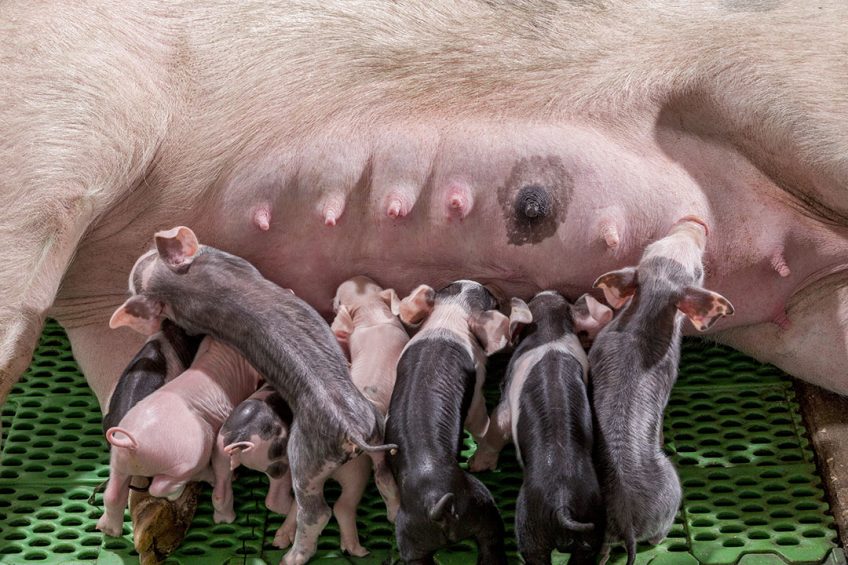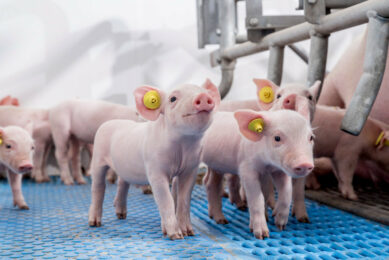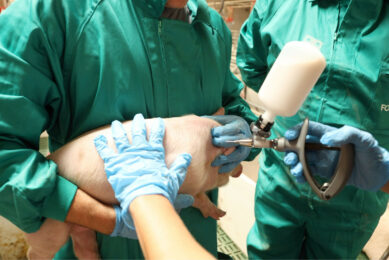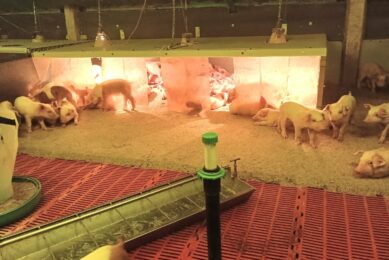Maintaining calcium levels in sow blood

Preparturient sows, the farrowing process and the piglets themselves interrelate in many ways. Zooming in on all these factors, it appears that calcium levels in a sow’s blood are likely to play a role in the farrowing process. That inspired the development of a new drinking water additive.
While hyperprolific sows and genetic selection continue to yield larger litters, swine producers remain challenged by an enduring problem: stillbirths. Stillbirth levels continue to hover around 10%; however, the problem is highly variable with farms reporting stillbirth ranges of 6–15% in individual herds. Higher stillbirth rates have been linked with neonatal mortality, presenting both an economic and animal welfare incentive to reduce the number of stillborn piglets.
Farrowing time, oxygenation and stillbirth risk
To understand how physiological factors within the sow, oxygen restriction during farrowing and the length of the farrowing process itself all contribute to stillbirths, it is helpful to understand the dynamics at work during farrowing. Within the sow, uterine contractions drive foetuses through the uterine horns towards the cervix. These contractions occur regularly (every 1 to 10 minutes) and may last 1 to 3 minutes. Contractions travelling along the uterine horns compress the piglets and more importantly their placentas, causing temporary reductions in oxygen-rich blood to the foetuses. If the farrowing process is extended (as is the case when more foetuses are present), the cumulative effect of insufficient oxygen will compromise the fitness of the piglets and in some cases cause stillbirth.
Piglets born late in the litter
Among piglets born later in the litter, the consequences of extended farrowing times can be seen in fewer live piglets born and reduced performance. Studies at the Trouw Nutrition Swine Research Centre found that piglets born late in the litter had more symptoms of poor oxygenation and performed less well in lactation and after weaning. Looking at performance, reduced oxygenation levels during farrowing negatively impact uptake of colostrum by the neonate, neonatal survival and gain during lactation and post-weaning phases.
Considering the calcium connection
Findings from studies comparing sows that experienced issues during the farrowing process to sows that farrowed an entire litter without a stillborn piglet, show that a sow’s ability to maintain calcium levels in the blood is a distinguishing factor when it comes to distress. In the last few hours before the onset of farrowing, a sow’s calcium levels may begin to drop. This decline is a consequence of the sow’s calcium requirement for colostrum secretion and for control of uterine contractions during farrowing.
In studies at the Swine Research Centre, scientists observed that sows farrowing litters without any stillborn piglets were able to maintain their blood calcium levels as farrowing approached. In contrast, scientists noted that sows with litters including stillborn piglets showed a clear drop in calcium levels.
Factors responsible for maintaining blood calcium levels
What factors are responsible for maintaining blood calcium levels? This question remains a topic of debate and is inspiring additional research regarding the proper levels of calcium supplementation in the sow’s diet. The sow’s calcium requirements for maternal and foetal growth in late gestation are 8–12 grams/day. Current lactation diets supply sows with 2 to 3 times these levels, even accounting for absorption losses. However, it is unclear how much the onset of colostrum production and uterine contractions close to farrowing add to the sow’s calcium requirements. It is also unclear whether calcium supplementation actually helps the sow or prevents the sow from utilising her own skeletal calcium reserves – a function required once lactation begins.
Water additive to reduce stillbirth
Findings from the research centre inspired researchers to develop a concept to support the preparturient sow and ultimately reduce stillbirths. Gestawean OxiLiv is a patented drinking water additive dosed in the sow’s drinking water from five days before farrowing until the sow has farrowed.
Water application removes the need for manual labour associated with alternative products such as top dresses, while also ensuring consistent 24-hour delivery to the sow. This two-pronged strategy helps the additive support the sow in maintaining her calcium levels prior to farrowing and also improves oxygenation of her piglets during the farrowing process.
A series of field trials conducted on commercial farms throughout Europe and in Canada show that the additive resulted in more piglets being born alive. The study farms in Table 1 included various genetics and showed a range in historical performance for stillbirth. In all farms, half of the sows received the drinking water additive dosed on the water line, and the other half received normal drinking water in the days prior to farrowing. Farm technicians recorded the number of piglets born alive, stillborn piglets and any interventions performed during farrowing (i.e. manual palpation and assistance or oxytocin injections).

Relationship between historical performance and drinking water additive’s benefit
On average, the drinking water additive’s benefit was +0.4 extra piglet born alive per litter. However, some studies achieved 0.5–0.7 extra piglet born alive per litter. Researchers noted an overall relationship between historical performance and the drinking water additive’s benefit. Farms experiencing higher stillbirth rates saw a higher benefit from the product than their counterparts that had relatively low stillbirth rates historically.
Assessing benefits
The nature of management practices on hyperprolific farms made other benefits more challenging to assess. For example, based on the product’s mode of action which improves oxygenation of piglets, it was expected that piglets would show improved vitality with lower pre-wean mortality. However, the frequent cross-fostering practices widely applied on the hyperprolific farms made it challenging to assure piglet traceability across treatments. On select farms where assessment of pre-wean survival was accurate, researchers observed that an extra 0.2–0.4 piglet survived to weaning, an additional benefit above the benefit at farrowing.
Herd welfare and production efficiency
As producers around the globe strive to optimise herd welfare and production efficiencies, the studies provide encouragement that progress can be achieved. To that end, Trouw Nutrition continues to invest in research to understand the interrelated factors surrounding the peripartal period. The ultimate win will be developing replicable strategies to increase the number of piglets born alive, and optimising pigs’ vitality across each life stage.











